Seed sowing is the process of inserting the seeds inside the soil to provide favourable condition for its germinate, flowering and fruiting. Without sowing we can’t produce food. The whole world depends on the sowing of seeds. It is one of the most basic and most important part of agriculture.
People are growing plants by sowing form years. Over these period of time, Different research, studies and experiments were done to find out the different methods of seed sowing to reduce the labour use and give optimum return.
Here, In this article – we will be discussing on these methods of seed sowing in detail along with their Advantages and Disadvantages.
Let’s the learning begin….
Methods Of Seed Sowing
We have listed the 7 best methods that are generally practiced by most of the farmers in the world:-
1.Broadcasting
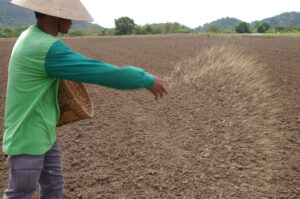
This is the most common and primitive method. Broadcasting simply means spreading of seeds over the ground. It can be done either manually or by mechanically. While doing manually, We take seeds in our hand and spread uniformly (As uniform as we can) over the soil. After that planking is done. Some seeds are covered while some remain uncovered and seed distribution is also uneven. While, Doing by mechanically – Amount of seed to be broadcasted is controlled. This leads to the uniform distribution of seeds over the soil. If done manually, It must be made sure that the person who is doing broadcasting must be skilled. It is also known as random sowing.
Tip:- To get proper germination all over the field by broadcasting method, We should spread/throw seeds in all direction. If done so, it is called criss-cross sowing.
This method is suitable for small seeds. If the seeds are too small like that of sesame and cotton, we should mix them with sand in proper ratio to maintain recommend seed rate. Otherwise, Too much seeds will be spread unknowingly. For Sesame:- Seed: Sand = 1:10
➡️Advantages:-
✓Easy and cheap method.
✓Saves time.
✓Skilled labour isn’t required.
✓It is best for small seeds like that of mustard and rapeseed.
➡️Disadvantages
✓As the seed rate/seed distribution isn’t uniform, It leads to the germination of more number of plants in some place of field while other place may remain barren. This leads to the use of more labour in intercultural practices.
✓All the seeds may not be covered by soil. So – Germination is poor and there is chance of lodging of plant during wind.
✓Proper seed rate and spacing can’t be maintained which ultimately reduce our production.
2.Drilling

Drilling is more advanced method of seed sowing that allows the proper control over seed rate and spacing. In this method, seeds are sown in continuous flow in furrow made by machine and are immediately covered with soil. It is done by the help of drillers. Different kinds of drilling machine are available in market. They can be manually operated or even automated. There is also availability of seed cum fertilizer drillers that helps to put fertilizer along with seed sowing at once. From my point of view, this is best method as it also facilitates to make 2-3 rows at a time.
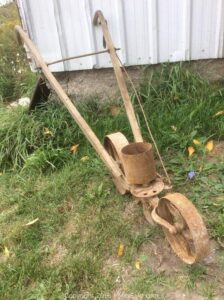
➡️Advantages:-
✓Saves a lot of time.
✓More control over seed rate.
✓Rapid Germination.
✓Seed are put in soil along with fertilizer.
➡️Disadvantages:-
✓Costly.
✓Technical knowledge is required.
3.Dibbling
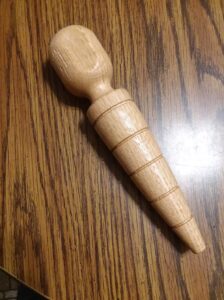
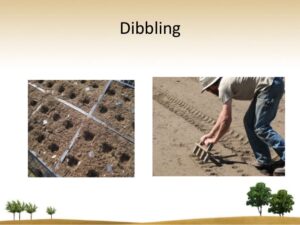
Dibbling is commonly used for vegetable cultivation as it is time consuming for other crops. In this method, Holes are made earlier with the help of dibblers by maintaining proper depth and distance. After that, Seeds are placed in those holes and finally covered with soil.
➡️Advantages:-
✓Proper depth, spacing and seed rate are maintained.
✓Proper covering of seed leading to good germination.
✓Less seeds required.
➡️Disadvantages:-
✓Time consuming and Costly process.
4.Sowing Behind The Plough
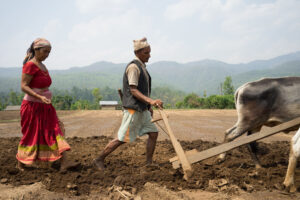
It is the conventional method of seed sowing. It is widely used to sow seeds of maize. In this world, a machine (Plough) makes furrow inland and a man behind it drops the seeds at particular spacing and proper seed rate. In general, A wooden Plough with a pair of bull are used for this method though other machines can also be used.
➡️Advantages:-
✓Easy and Cost effective method.
✓Proper spacing and seed rate can be maintained.
➡️Disadvantages:-
✓Time consuming and need more labour.
✓Less control over the depth of seed sown as it is governed by the depth of furrow made by the plough.
5.Hill Dropping
Hill can be understood as a place in field in which seeds are drop. There are certain number of hills in a certain field. These are made at a good distance but not continuously. In these hills, Seeds are dropped.
6.Check Row Planting
In this method, Exact row-row and plant-plant distance can be maintained. The machine used for this process is check-row planter.
7.Transplanting
Technical, We can’t say the sowing of seed during transplanting as seedlings are sown. In this method, First seeds are raised in nursery for some period of time and later they are transplanted to main field. For Example:- Rice Transplanting.
Final Verdict
Thus – These were the top 7 and most commonly used method of seed sowing. They have their own advantages and disadvantages. One suited for one kind of seeds may not be suitable for another kind of seed. Therefore, It is better to choose the best method to get optimum return at minimum investment.
You May Like These Articles:-
60 Examples Of Monocot And Dicot Plants
